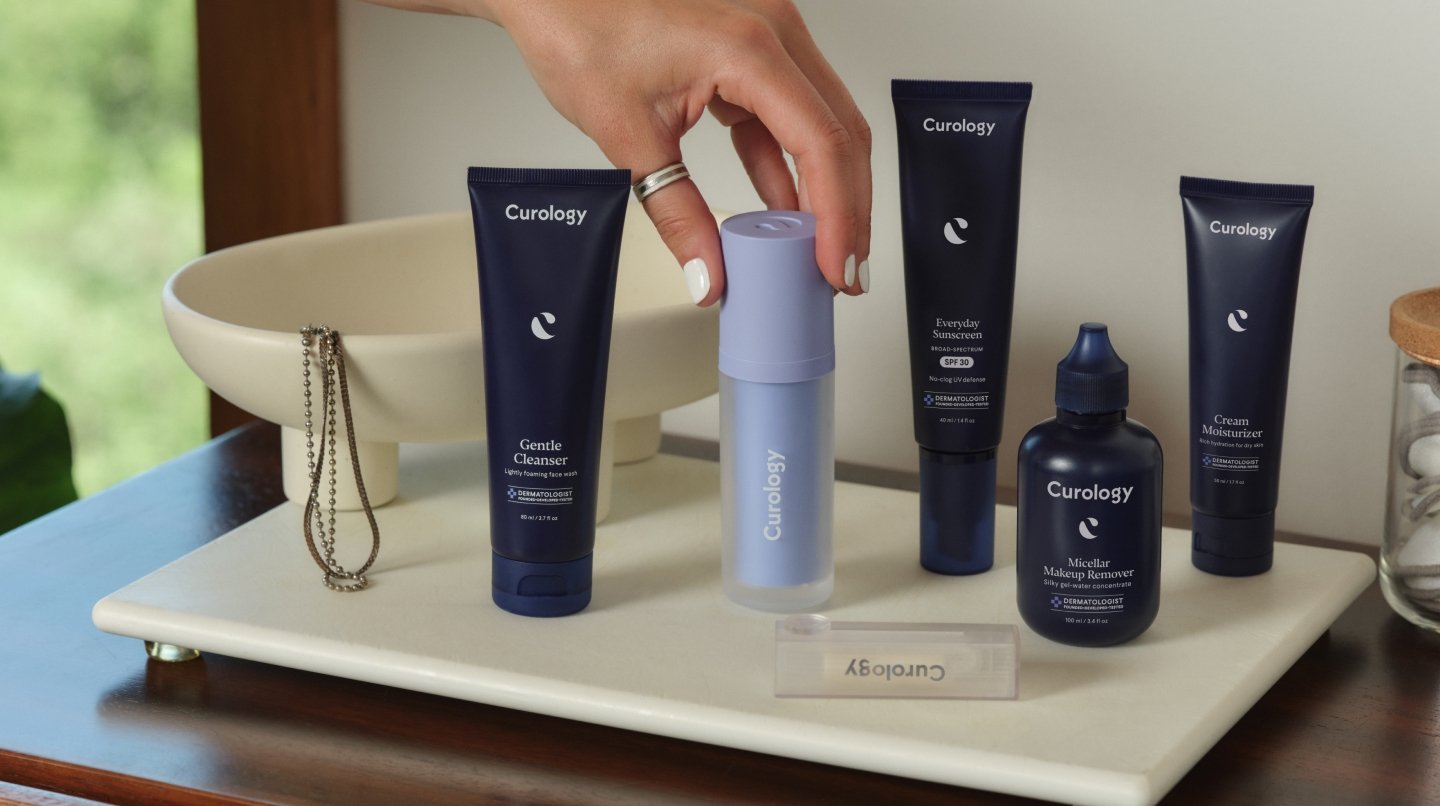How it works:
Share your skin goals and snap selfies
Your dermatology provider prescribes your formula
Apply nightly for happy, healthy skin
How it works:
How it works:
Share your skin goals and snap selfies
Your dermatology provider prescribes your formula
Apply nightly for happy, healthy skin
How it works:
Ask an expert: Is it a pimple or is it keratosis pilaris?
Learn to identify keratosis pilaris and discover other possible explanations for those tiny bumps on your skin.



You’ve typed “Why do I have little bumps on my knees?” into the search bar and the first few articles that pop up talk about pimples and keratosis pilaris. These are two conditions that don’t appear on the knees, but they can appear elsewhere on the body!
Keratosis pilaris is a common, harmless skin condition that appears in the form of non-contagious, small, painless bumps around the upper arms, thighs, and buttocks. Bumps on the knees that look like pimples aren’t pimples (or keratosis pilaris!). We’ll touch on that in a bit. But first, let’s unpack keratosis pillars symptoms, causes, and treatment.
Keratosis pilaris: What is it?
Some people refer to keratosis pilaris as chicken skin. It can also resemble goosebumps. These little growths most commonly appear on the upper arms, thighs, or buttocks.¹ It’s a harmless condition caused by an overproduction of keratin, a protein found in hair, skin, and fingernails. When keratin builds up in your hair follicles, tiny bumps can appear.² They’re not painful and may go away on their own. That said, there are also ways to help manage them. We’ll share those below.

Contributing factors to keratosis pilaris
Keratosis pilaris develops when hair follicles get clogged with a protein called keratin. It can block hair follicles or pores and cause bumps to develop. It’s not from a fungus, bacteria, or virus, and it’s not contagious. It occurs in roughly 50-80% of adolescents and 40-50% of adults.³ Pimples on the knees of a child likely aren’t keratosis pilaris (or acne!). It develops on extensor surfaces (typically on the upper arm, thighs, and buttocks) and can develop on the cheeks, especially in children. It can worsen during pregnancy or after childbirth. The good news—often improves or clears up with age.
What causes the body to overproduce keratin remains unknown, but potential risk factors may include:
A family history of keratosis pilaris
Specific genetic changes⁴
Other skin conditions, like eczema
Obesity or excess body weight
Medical conditions such as diabetes and down syndrome
Dry skin
What do these bumps look like?
Keratosis pilaris is usually easy to recognize based on its location on the body and the characteristics of the bumps. We’ll share the common characteristics, but before we do, we want to say the information we share here shouldn’t replace qualified care from a licensed dermatology provider or medical provider. Your healthcare provider is the one who will make the official diagnosis. If you’re experiencing bumps—be it keratosis pilaris or something else—and they become painful or don’t clear up on their own, or you have other symptoms, it’s important to see your medical provider.
You’ll notice tiny patches of rough bumps on your skin. Other common characteristics may include:
Itchy or dry skin: This is usually most prevalent on your upper arms, legs, or butt. The itchiness can be more intense when your skin is dry.
Discoloration: When the bumps become irritated, they can become discolored and more noticeable. Bumps can be skin-colored, red, white, brown, or black depending on the person’s skin color.
Rough, sandpaper-like skin: Your skin may become rough or feel sort of like sandpaper in the affected area.
Noticeable differences in winter or dry climates: Keratosis pilaris may worsen in the winter or dry climates and improve during the warmer months.⁵
Painlessness. Keratosis pilaris is generally painless, so if you experience pain while pressing or prodding at your bumps, it may be something else.

How do you treat keratosis pilaris?
There’s no cure for keratosis pilaris yet, but you can do things to help minimize the symptoms Spoiler alert: Popping them is not one of them! Picking, squeezing, and attempting to pop little bumps often makes matters only worse. Instead, we recommend using one or a combination of the following options:
Use ingredients that promote cell turnover or remove dead skin cells.⁶ Retinoids (including prescription-strength tretinoin), alpha-hydroxy acids (AHAs), and beta-hydroxy acids (BHAs) are exfoliants that remove dead skin cells and promote cell turnover. Most are available over the counter. Common AHAs include lactic acid and glycolic acid. Salicylic acid is a common BHA.
Keep your skin moisturized. Dry skin is a common symptom of keratosis pilaris, so keep your skin hydrated. Choose hydrating ingredients, including glycerin, aloe, and hyaluronic acid, to attract and lock in moisture.
Wear soft, loose-fitting clothes. Friction from clothing can aggravate keratosis pilaris. Give your skin room to breathe by opting for soft, breathable fabrics like cotton or linen.
Gently exfoliate. A konjac sponge can gently remove dead skin cells from the skin’s surface. Avoid harsh salt or sugar scrubs.
What about the pimples on my knees?
While pimples can occur on the face, neck, chest, back and shoulders, they don’t appear on the knees. Most often, small bumps on the knee cap are from another cause like ingrown hairs, shaving irritation, folliculitis, or a reaction from lotion or another comedogenic (aka pore-clogging) product.
Keratosis pilaris can happen when your pores become clogged due to the buildup of keratin. In contrast, acne forms when your pores become clogged with excess sebum and dead skin cells. Bacteria thrive in the excess sebum and lead to inflammation. This is what causes the formation of whiteheads, blackheads, papules, pustules, nodules, and cysts. Acne is an inflammatory skin condition that currently has no cure, but it is treatable!
Can Curology treat keratosis pilaris?
While your personalized Curology formula typically treats acne, anti-aging, and rosacea symptoms on your face and neck, as a Curology member, you can talk to your dermatology provider for help with other skin issues, like keratosis pilaris. We’re always here to help. And with a team of dedicated licensed dermatology providers, we have the resources to find answers to your questions!
Get your personalized skincare routine with Curology
Get your personalized skincare routine with Curology


Not a member yet? Sign up for a free trial of Curology to get matched with one of our in-house dermatology providers today. Just take a quick skin quiz and send us some selfies. If Curology is right for you, we’ll send you a 30-day supply of our recommended products for just $4.95 shipping and handling.* Your order will include your personalized prescription formula designed to treat your unique skincare concerns.
FAQs
Some people refer to keratosis pilaris as chicken skin. It can also resemble goosebumps. These little growths most commonly appear on the upper arms, thighs, or buttocks. It’s a harmless condition caused by an overproduction of keratin, a protein found in hair, skin, and fingernails. When keratin builds up in your hair follicles, tiny bumps can appear. They’re not painful and may go away on their own.
You’ll notice tiny patches of rough bumps on your skin. Other common characteristics may include:
Itchy or dry skin
Discoloration
Rough, sandpaper-like skin
Noticeable differences in winter or dry climates
Painlessness
There’s no cure for keratosis pilaris yet, but you can do things to help minimize the symptoms. We recommend using one or a combination of the following options:
Use ingredients that promote cell turnover or remove dead skin cells
Keep your skin moisturized
Wear soft, loose-fitting clothes
Gently exfoliate
While pimples can occur on the face, neck, chest, back and shoulders, they don’t appear on the knees. Most often, small bumps on the knee cap are from another cause like ingrown hairs, shaving irritation, folliculitis, or a reaction from lotion or another comedogenic product.
Keratosis pilaris can happen when your pores become clogged due to the buildup of keratin. Acne is an inflammatory skin condition that currently has no cure, but it is treatable!
P.S. We did the homework so you don’t have to:
Thomas, M., & Khopkar, U. S. Keratosis pilaris revisited: is it more than just a follicular keratosis?. International journal of trichology. (2012).
American Academy of Dermatology. Keratosis Pilaris: Overview. (n.d.).
Brandt, F., et al. A clinical investigation on the improvement and apparent resolution of keratosis pilaris with a novel photopneumatic therapy: A pilot study.Journal of the American Academy of Dermatology. (2008, February 1).
Pennycook, K.B., et al. Keratosis Pilaris.StatPearls. (2022, June 27).
Pennycook, K.B., et al. Keratosis Pilaris. Ibid.
American Academy of Dermatology. Keratosis pilaris: Self-care. (n.d.).
* Curology dermatology providers include NPs, PAs, MDs, and DOs.
** Subject to consultation. Subscription is required. Results may vary.

Curology Team

Meredith Hartle, DO
Related Articles
How to use acne body wash correctly: Your straightforward guideMen skin care: top concernsHow to get rid of body and back acne?Sunscreen for eyes: How to protect your delicate skin from UV raysYour first weeks on CurologyPopular Articles
Ask Curology: Is my cold breaking me out?Slugging: The dermatologist-approved skincare hack going viral on TikTokTretinoin vs retinol: What’s the difference?How to create a self-care routine that actually sticksYour 2023 skincare horoscopeTry prescription skincare
Get routine essentials

Good skin days ahead
- Breakouts
- Redness
- Fine lines
- Dark spots
- Hair thinning